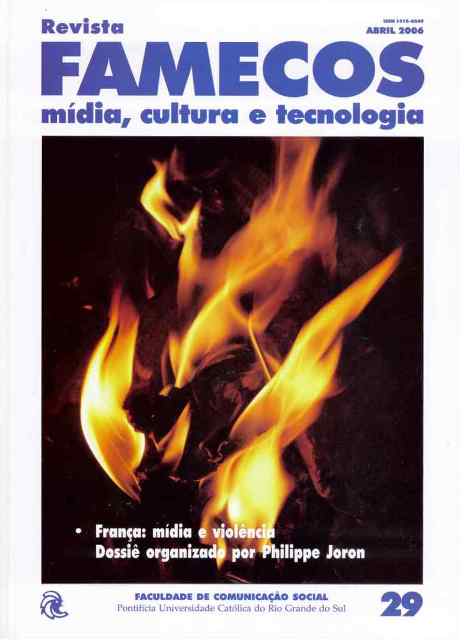Strong prejudice like a lion: black representations and media violence
DOI:
https://doi.org/10.15448/1980-3729.2006.29.3362Keywords:
Communication, representation, preconceptionAbstract
Prejudices against blacks are the same everywhere. They still insist on the alleged intellectual inferiority of supposedly violent individuals with a high sexual appetite. Our analysis focuses on North American examples as the United States continues to be the great factory of globalized media images.Downloads
References
BAUDRILLARD, Jean. Amérique. Paris: Grasset, Coll. Le Livre de Poche, 1986.
BINET, Stéphanie. 50 Cent, premier degré. Libération, jun. 2003.
BLANCHARD, Pascal; BANCEL, Nicolas, et al. La fracture coloniale: La société française au prisme de l’héritage colonial. Paris: Editions La Découverte, 2005.
BLUMENFELD, Samuel. On nous montre comme des vilains et non comme des héros. Entrevista com Chase Brandon, du Bureau des Relations Publiques de la CIA. Le Monde, 23 jul. 2002.
BOURDIEU, Pierre; WACQUANT, Loïc. La Nouvelle vulgate planétaire. Le Monde Diplomatique, Mai 2000.
CATHUS, Olivier. L’Âme-sueur. Le Funk et les musiques populaires. Paris: Desclée de Brouwer, 1998.
COATES, Ta-Nehisi. Keepin’ It Unreal. Selling the Myth of Bla¢k Male Violen¢e, Long Past Its Expiration Date. Village Voice, juin 2003.
CORRELL, Joshua; WITTENBRINK, Bernd et al. The Police Officer’s Dilemma: Using Ethnicity to Disambiguate Potentially Threatening Individuals. Journal of Personality and Social Psychology, v. 83, n. 6, 2002.
DA MATTA, Roberto. Carnavals, bandits et héros. Paris: Seuil, 1983.
DUCLOS, Denis. Le Complexe du loupgarou. La fascination de la violence dans la société américaine. Paris: Ed. La Découverte, 1994.
DUNCAN, B.L. Differential social perception and attribution of intergroup violence: Testing the lower limits of stereotyping of blacks. Journal of Personality and Social Psychology, 1976.
DURAND, Gilbert. Les Structures anthropologiques de l’imaginaire. Paris: Dunod, 1969.
ELIADE, Mircea. Méphistophélès et l’’Androgyne. Paris: Gallimard, 1962.
FREDRICKSON, George M. Still separate and unequal. In: The New York Review of Books, v. 52, n. 18, nov. 2005.
GOFFMAN, Erving. Stigmates. Les usages sociaux des handicaps. Paris: Ed. de Minuit, 1977.
HALL, Alice. The World in the Screen: The Impact of Character Representativeness, Society Variability, and Presentation on Audiences’ Conceptualization of Cross-cultural Media Images. TBS (Transnational Broadcasting Studies), n. 6, Spring/Summer, 2001.
KATZ, Elihu; LAZARSFELD, Paul. Personal Influence. New York: The Free Press, 1957.
KANG, Jerry. Trojan Horses of Race. Harvard Law Review, n. 118, fev. 2005.
KITWANA, Bakari. The Cotton Club. Village Voice, 2005.
LELAND, John. Hip: The History. New York: HarperCollins Publishers, 2004.
MAFFESOLI, Michel. L’Ombre de Dionysos. Paris: Méridiens, 1985.
MERTON, Robert King. Eléments de théorie et de méthode sociologique. Paris: Plon, 1965.
MORIN, Edgar. L’Esprit du temps. Paris: Grasset, 1962.
RUX, Carl Hancock. Eminem: the new white negro. In: TATE, Greg. Everything but the burden. New York: Random Books, 2003.
SLIM, Iceberg. Pimp. Paris: Editions de l’Olivier, Collection Soul Fiction, 1998.
TATE, Greg (org.). Everything but the burden. New York: Random Books, 2003.
TOSCHES, Nick. Héros oubliés du Rock’n’roll. Les années sauvages du rock avant Elvis. Paris: Editions Allia, 2000.
VELOSO, Caetano. Noites do Norte, CD, Universal, 2000.
Downloads
Published
How to Cite
Issue
Section
License
Copyright
The submission of originals to Revista Famecos implies the transfer by the authors of the right for publication. Authors retain copyright and grant the journal right of first publication. If the authors wish to include the same data into another publication, they must cite Revista Famecos as the site of original publication.
Creative Commons License
Except where otherwise specified, material published in this journal is licensed under a Creative Commons Attribution 4.0 International license, which allows unrestricted use, distribution and reproduction in any medium, provided the original publication is correctly cited.






